| |
Osteoporosis in Men
|
| |
| |
NEJM April 3, 2008
Peter R. Ebeling, M.D.
From the Department of Medicine, Royal Melbourne Hospital/Western Hospital, and the Department of Endocrinology, University of Melbourne, Western Hospital, Melbourne, Victoria, Australia.
This Journal feature begins with a case vignette highlighting a common clinical problem. Evidence supporting various strategies is then presented, followed by a review of formal guidelines, when they exist. The article ends with the author's clinical recommendations.
A 65-year-old asymptomatic man is concerned about his risk of osteoporosis. His mother died after a hip fracture at 74 years of age. The patient has no history of fractures but has lost 7.6 cm (3 in.) in height; he does not smoke and has never taken corticosteroids. He drinks two glasses of beer (16 oz, or about 0.5 liter, each) per day. His body-mass index (the weight in kilograms divided by the square of the height in meters) is 25. Measurements of bone mineral density with the use of dual-energy x-ray absorptiometry show T scores of -2.6 at the spine and -2.2 at the femoral neck, findings that are consistent with osteoporosis. What should you recommend?
The Clinical Problem
Osteoporosis continues to be an under-recognized problem in men, and it goes untreated in the majority of men with fractures. One third of all hip fractures worldwide occur in men,1 and more men than women die in the year after a hip fracture, with a mortality rate in men of up to 37.5%.2 Up to 40% of hip fractures in men occur among those in residential care facilities, and 20% of men who sustain a hip fracture have a second hip fracture. Although the very elderly are at highest risk, almost half of hip fractures in men occur before the age of 80 years.3
Vertebral fractures are also common among elderly men; however, incidence rates among men, unlike those among women, decline at older ages (many earlier fractures may be due to trauma),4,5,6 and rates among men over the age of 65 years are only half those among women. The majority of vertebral fractures (70 to 85%) are painless but are associated with height loss, reduced quality of life, respiratory dysfunction,7 increased risk of death, and subsequent hip and other fractures. The observation that the majority of fractures occur in men whose bone mineral density measurements are not in the osteoporotic range underscores the importance of factors other than bone mineral density in determining the risk of fracture.8
Secondary Causes of Bone Loss in Men
Osteoporosis in men often has secondary causes (Table 1). The most frequent secondary causes are corticosteroid use, excessive alcohol use, and hypogonadism (Table 1).9 In a study of elderly male nursing-home residents with hip fractures, up to 66% had hypogonadism,10 whereas in a study of men with spinal fractures, hypogonadism was present in 20% of the men and in most cases was asymptomatic.
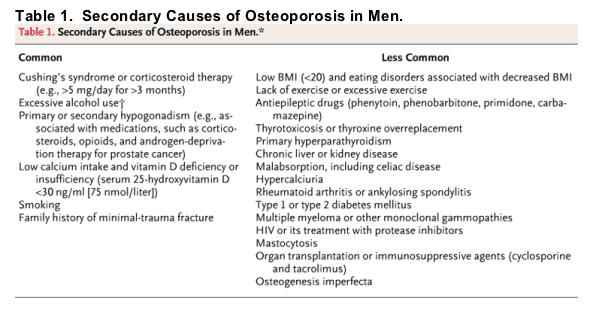
Other secondary causes combined account for only about 15% of cases.9 Among these secondary causes, vitamin D deficiency should be considered routinely; serum levels of 25-hydroxyvitamin D below 25 ng per milliliter (62.5 mmol per liter) are associated with an increased risk of hip fracture in men and women older than 65 years.11 Estrogen levels are also important for the male skeleton; testosterone exerts indirect effects on bone through its aromatization to estrogen.9 In rare cases, mutations of the estrogen receptor or the aromatase enzyme have been associated with severe osteoporosis in men.12,13 In up to 40% of cases in men, no secondary cause is identified, and the osteoporosis is considered to be primary or idiopathic.
Natural History of Bone Loss in Men
Longitudinal studies suggest that in men bone loss accelerates after the age of 70 years14; rapid bone loss is more common with deficient testosterone or estradiol levels.15 In contrast to bone loss in women, who lose trabeculae with age, in men bone loss due to trabecular thinning is secondary to reduced bone formation.16 The preservation of trabecular numbers in men may help explain their lower lifetime risk of fractures (Figure 1). In men, trabecular bone loss starts early in life, in association with changes in the insulin-like growth factor 1 (IGF-1) regulating system, whereas cortical bone loss occurs later (85% occurs after 50 years of age), in association with decreases in bioavailable testosterone and estrogen and increased bone remodeling.17

Changes in the trabecular bone structure at the ultradistal radius are shown in men 24, 48, and 73 years old (Panels A, B, and C, respectively), on high-resolution peripheral quantitative computed tomography, a noninvasive technology. Trabecular microstructural variables are also indicated: BV/TV denotes bone volume, TbN trabecular number, TbTh trabecular thickness, and TbSp trabecular spacing. In Panel A, the arrow indicates prominent platelike trabeculae in this young man, which are absent or less prominent in the older men. Adapted from Khosla et al.16
Strategies and Evidence
Diagnosis
Bone mineral density, measured by dual-energy x-ray absorptiometry, is a robust predictor of fractures. Each decrease of 1 SD in hip bone mineral density is associated with an increased relative risk of hip fracture of 2.6. Although the relationship between bone mineral density and fracture is a continuous one, a World Health Organization (WHO) working group has assigned thresholds for the diagnosis of osteoporosis and osteopenia in postmenopausal women, using total-hip bone mineral density (Table 2). These thresholds are now applied to other anatomical sites and to men.
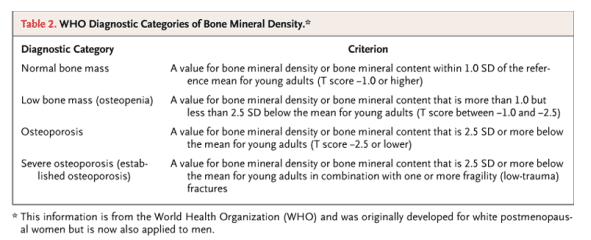
Recent epidemiologic data suggest that for any given absolute bone mineral density value at the spine or hip, the risk of fracture is similar among men and women of the same age.18,19,20 Nevertheless, the average bone mineral density in men who fracture a hip is higher than in women, suggesting that other factors (bone microarchitecture or trauma) may contribute to the risk of fracture more in men than in women. For diagnostic purposes, this discrepancy is addressed by use of a sex-specific T score, but this practice remains controversial. Using male-specific cutoffs for hip bone mineral density, the National Health and Nutrition Examination Survey III study showed that 6% of U.S. men who were 50 years of age or older had osteoporosis and 47% had osteopenia,21 as compared with corresponding prevalences in women of 18% and 50%, respectively. If female reference ranges were used in men, the prevalences of osteoporosis and osteopenia would be reduced by two thirds.
Bone densitometry is recommended in men 70 years of age or older �\ or earlier in men with major risk factors for osteoporosis (Table 3 and Figure 2). Measurements of bone mineral density at the femoral neck are preferable to spinal measurements. Patients should be assessed routinely for risk factors for osteoporosis (Table 3) and for clinical signs of secondary causes (Table 1).
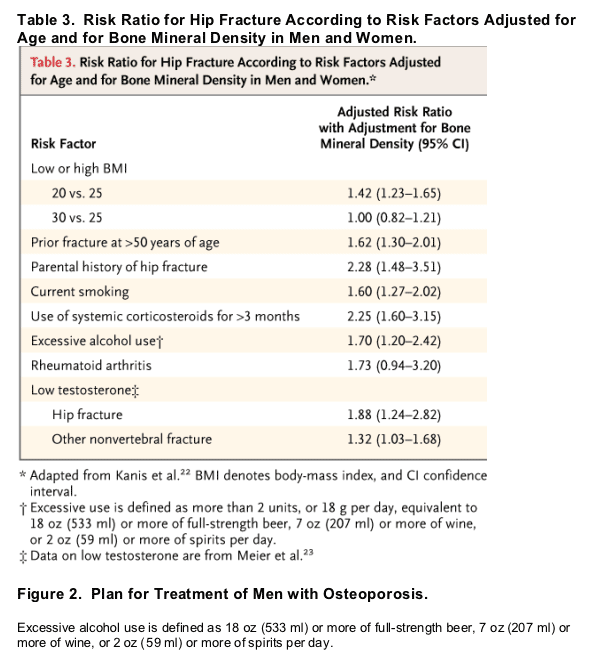

Additional Testing
Laboratory Tests
Further testing is strongly indicated to rule out secondary causes when the z score is below -2.0 (2 SD below the age-specific mean) on bone densitometry. Routine tests include measurements of serum calcium and creatinine levels, liver-function tests, measurement of the thyrotropin level, and a complete blood count. If clinically indicated, serum protein electrophoresis and tests for urinary Bence Jones protein (to check for monoclonal gammopathy), anti-tissue transglutaminase antibodies (to check for celiac sprue), 24-hour urinary cortisol or calcium, and human immunodeficiency virus antibodies should be performed.
Since hypogonadism is often difficult to detect on the basis of the patient's history and the physical examination alone, measurement of the total testosterone level is recommended in all men with osteoporosis. Sex hormone-binding globulin levels may provide additional information in some cases (e.g., in men with insulin resistance or obesity, in whom low levels of sex hormone-binding globulin may complicate interpretation of total testosterone levels).
Serum levels of 25-hydroxyvitamin D should also be measured. Levels below 30 ng per milliliter (75 nmol per liter) should be treated.
There are limited data relating markers of bone turnover to the risk of fracture among men.24 These markers show high biologic variability, and their measurement has not been shown to improve outcomes in men with osteoporosis, so their routine use in practice cannot currently be recommended. However, they may be useful for men in whom no apparent cause of osteoporosis can be detected on other tests and for men with very low bone mineral density to detect low levels of bone formation.
Vertebral-Fracture Assessment
A history of a minimal trauma fracture after the age of 50 years is the strongest clinical risk factor for fracture.25 Recognition of fractures is important for risk stratification, particularly in men with osteopenia. Among minimal trauma fractures, vertebral fractures are most common and are often clinically silent. Spinal radiography is useful for diagnosis, but it is costly and involves a relatively high dose of radiation.26 Assessment of vertebral fracture is now possible with dual-energy x-ray absorptiometry. Images of the lateral spine can be obtained with the use of newer machines and special software,27 with high sensitivity and specificity for moderate fractures (height loss, 30 to 40%) and severe fractures (height loss, more than 40%), but spinal radiographs remain the gold standard.28 The finding of mild vertebral deformities with the use of dual-energy x-ray absorptiometry is less specific and should be differentiated from nonosteoporotic short vertebral height (height loss, 15% or less, without central endplate compression), a common finding on spinal radiographs.29
Management
Decisions regarding treatment should be based on the absolute risk of fracture. The bone mineral density measurement is a key factor in decision making. A WHO working group has identified the clinical risk factors that can be used to predict the risk of fracture independently of bone mineral density in both sexes (Table 3)22,30; use of these factors along with bone mineral density is considered to improve fracture prediction as compared with the use of bone mineral density alone. Country- and ethnic group-specific risk-assessment tools incorporating clinical risk factors with age and bone mineral density measurements are now available to calculate the risk of fracture in men 50 years of age or older (FRAX is the new fracture risk assessment tool from the WHO). These tools are the best adjunct to measurement of bone mineral density in calculating the risk of hip fracture in men.31 Biomarkers such as low testosterone levels23 and low levels of 25-hydroxyvitamin D are also useful in predicting an increased risk of fracture.
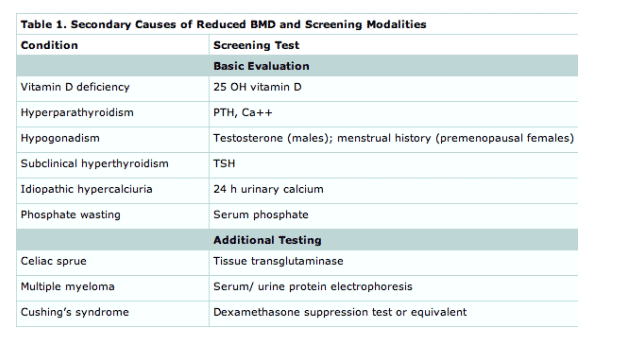
from Todd Brown, MD, Johns Hopkins
Nonpharmacologic Therapy
General preventive and lifestyle measures apply to all men (Table 4). In healthy older men, high-intensity, progressive resistance training, weight-bearing exercise, or both32 increase bone mineral density as compared with that in controls. Although there is a lack of data from clinical trials showing that these changes in bone mineral density translate into a reduced risk of fracture, observational data suggest a lower risk among older men who maintain an active lifestyle.33 Meta-analyses of trials show that balance and strengthening exercises reduce the risk of falls among older adults.34 Fall-prevention strategies,35 although beyond the scope of this review, should be implemented. Hip protectors have been suggested as a means of reducing the risk of hip fracture among the elderly, but a recent trial involving elderly male and female nursing-home residents showed no significant benefit.36
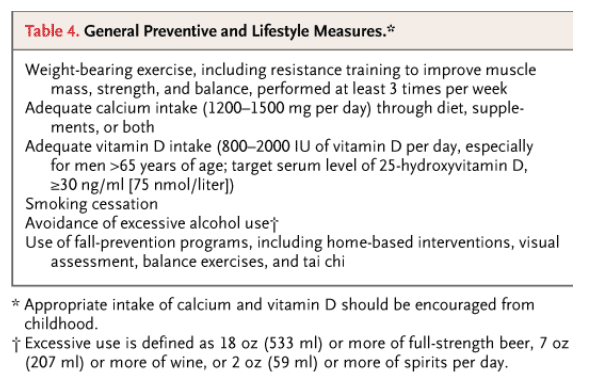
Calcium and vitamin D supplements are often recommended to maintain bone mineral density. Although there are conflicting data on the benefits of supplementation, a recent systematic review of nearly 64,000 participants in randomized trials showed that ingestion of calcium (1200 mg or more daily) or calcium with vitamin D (800 IU or more daily) reduced osteoporotic fractures by 12% in both men and women 50 years of age or older.37 Fracture reduction appeared to be greater among participants who had at least an 80% rate of compliance with calcium and vitamin D recommendations (24% risk reduction, vs. 12% among participants with a lower compliance rate) and among those with a daily intake of at least 1200 mg of calcium and at least 800 IU of vitamin D. In a trial comparing calcitriol (0.50 μg daily) with calcium supplementation (1 g daily) in men with osteoporosis, changes in bone mineral density were similar in the two groups over a period of 2 years.38 Recommendations support supplementation with cholecalciferol at doses of 800 to 2000 IU daily,39 with the goal of maintaining serum levels of 25-hydroxyvitamin D at 30 ng per milliliter or more. The recommended daily intake of calcium for men with osteoporosis is 1200 to 1500 mg.
Pharmacologic Therapy
Pharmacologic therapy is indicated in men with T scores below -2.5 or with less marked bone loss and a vertebral fracture. Most experts would also recommend treatment for men with osteopenia and a nonvertebral fracture after minimal trauma (Figure 2).
Bisphosphonates
A randomized, double-blind trial involving 241 hypogonadal or eugonadal men with osteoporosis showed that treatment with 10 mg of alendronate per day for 2 years increased bone mineral density in the spine and femoral neck40 and significantly reduced the incidence of radiologic, but not clinical, vertebral fractures at 2 years (0.8%, vs. 7.1% in the placebo group). The trial was not powered to assess reductions in other fractures.
In an open-label study, men with osteoporosis taking the oral bisphosphonate risedronate at a dose of 5 mg per day for 1 year had increased bone mineral density in the spine and proximal femur41 and a reduced risk of radiologic vertebral fractures; however, a weakness of the study was the lack of blinding. More data are required to determine the effects of oral bisphosphonates on nonvertebral and hip fractures in men with osteoporosis.
In a recent randomized trial, the intravenous bisphosphonate zoledronic acid, given in one or two 5-mg doses over the course of 23 months, reduced overall rates of clinical fracture and death, but not the rate of hip fracture, among elderly men and women with a previous hip fracture.42 Potential adverse effects of zoledronic acid include fever and myalgia and worsening of renal impairment. The use of both intravenous and oral bisphosphonates has in rare cases been linked to osteonecrosis of the jaw, although the limited data now available indicate few cases in patients receiving doses used for osteoporosis.43
Anabolic Agents
Anabolic agents may correct an underlying defect in osteoblast function, which has been implicated as a cause of osteoporosis in men.44 Trials show that daily subcutaneous administration of 20 μg of teriparatide (parathyroid hormone [1-34]) increases the bone mineral density of the spine and proximal femur in hypogonadal or eugonadal men with osteoporosis.45 In follow-up studies, previous therapy with teriparatide was associated with a reduction in the risk of moderate or severe vertebral fractures.46 Data on the effects of teriparatide on nonvertebral fractures in men are lacking. The increase in bone mineral density stimulated by parathyroid hormone therapy in men was blunted when parathyroid hormone was given with alendronate47 but not when it was given after risedronate.48 After parathyroid hormone therapy is stopped, initiation of bisphosphonate therapy is recommended, since this strategy results in further gains in bone mineral density.49 Side effects of teriparatide, which are mild, include dizziness and leg cramps (in less than 10% of patients). An increased risk of osteosarcoma was observed with teriparatide in an oncogenicity study in rats, but it has not been shown in humans. This agent is suitable for men with severe osteoporosis and in those who cannot tolerate or do not have an adequate response to bisphosphonates.
Testosterone Therapy
Studies of testosterone in men with osteoporosis are limited, and none have used fractures as a primary end point. The effects of testosterone on cortical and trabecular bone mass are greatest when it is used in hypogonadal adolescents.50 In a 3-year study of hypogonadal men over 65 years of age, those receiving testosterone-replacement therapy had an 8.9% greater increase in the bone mineral density of their spine than did those receiving placebo.51 In a 2-year observational study in hypogonadal men, magnetic resonance imaging studies showed that testosterone therapy was associated with improvements in trabecular connectivity.52
The effects of testosterone in eugonadal men are more controversial. In one study, transdermal testosterone did not increase bone mineral density in eugonadal elderly men over 65 years of age, as compared with placebo,53 whereas intramuscular testosterone improved spinal bone mineral density in men with osteoporosis in observational studies.54,55 Differences in response may be related to pretreatment testosterone levels. In a prespecified analysis in the first study,53 men with a testosterone level below 200 ng per deciliter had significant increases in spinal bone mineral density with treatment. The risks of testosterone therapy, which include polycythemia, sleep apnea, benign prostate enlargement, and possibly prostate cancer, argue against its use in eugonadal men with osteoporosis until additional data are available to support this strategy.
Areas of Uncertainty
The optimal interval at which to obtain follow-up bone mineral density measurements is controversial. An interval of 2 years seems reasonable in men whose care is managed with or without pharmacotherapy. The efficacy and safety of testosterone treatment for osteoporosis require further assessment. Reduction of nonvertebral and hip fractures with the use of oral bisphosphonates in men has yet to be demonstrated.
Data are limited on the cost-effectiveness of screening for and treating osteoporosis in men. In one analysis, the threshold probability for cost-effective treatment was a 10-year risk of hip fracture that ranged from 2% at the age of 50 years to 6.5% at the age of 80 years.22 Bone densitometry followed by bisphosphonate therapy may be cost-effective for U.S. men with osteoporosis who are 65 years of age or older and have had a previous clinical fracture and for those 80 years of age or older with no previous fracture. This strategy may also be cost-effective for men as young as 70 years without a previous clinical fracture, if the cost of oral bisphosphonate therapy is below $500 per year,56 as it is in some countries.
Guidelines
The International Society for Clinical Densitometry recommends bone mineral density screening in men 70 years of age or older and recommends earlier screening if there is a fragility fracture or other known condition conferring a predisposition to osteoporosis.57 Canadian clinical practice guidelines from 2002 recommend screening in men 65 years of age or older (though cost-effectiveness data are lacking).58 These guidelines recommend bisphosphonates as first-line treatment for men in this age group whose bone mineral density is in the osteoporotic range, for men over the age of 50 years who have had fractures and have a T score below -1.5, and for men of any age who have osteopenia and have taken corticosteroids for 3 or more months or who have hypogonadism. Recent National Osteoporosis Foundation guidelines59 recommend pharmacologic therapy in men 50 years of age or older with hip or vertebral fractures; in men with a T score below -2.5; and in men with a T score between -1.0 and -2.5 with either a 10-year hip fracture probability of 3% or more or a total minimal trauma fracture probability of 20% or more.
Conclusions and Recommendations
Osteoporosis in men continues to be underdiagnosed and undertreated. In men 70 years of age or older and in younger men with clinical risk factors for osteoporosis, such as the man in the vignette, bone density should be measured by dual-energy x-ray absorptiometry. I would also measure levels of serum total testosterone and 25-hydroxyvitamin D. A calcium intake of at least 1200 mg per day and vitamin D supplementation of at least 800 IU per day should be recommended, as should regular weight-bearing exercise. A T score of -2.5 or less indicates bone loss; evidence of vertebral fracture would be an indication for pharmacologic therapy. An oral bisphosphonate, currently considered first-line treatment for osteoporosis in men, should be recommended, with patient education regarding potential side effects.
Supported by grants from the University of Melbourne and the National Health and Medical Research Council of Australia.
Dr. Ebeling reports receiving consulting fees from Merck, Amgen, and GlaxoSmithKline, lecture fees from Merck and Eli Lilly, and research funding from Novartis, Amgen, and GlaxoSmithKline. No other potential conflict of interest relevant to this article was reported.
|
|
| |
| |
|
|
|